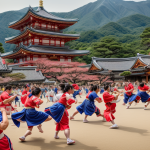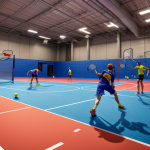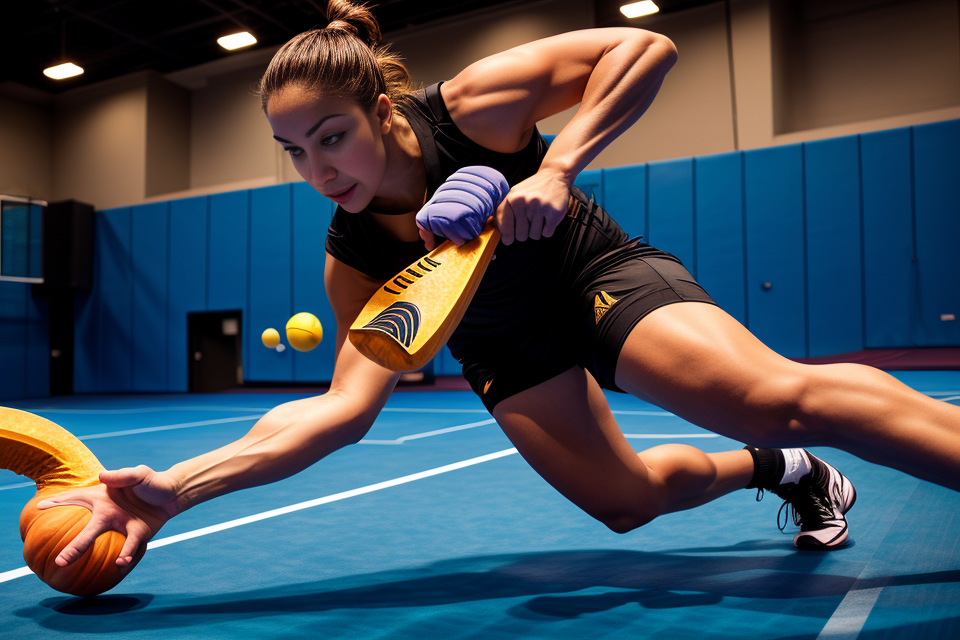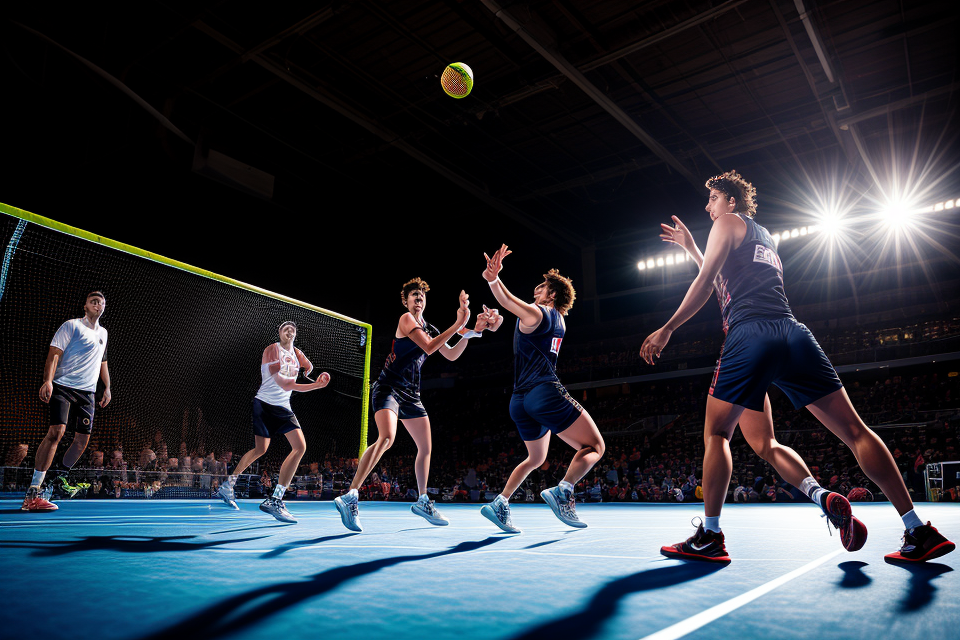Squash is a physically demanding sport that requires quick movements, powerful hits, and precise footwork. As a result, it is not uncommon for players to experience arm injuries while playing squash. Squash arm injuries can range from minor strains and sprains to more severe injuries such as tendonitis or even a complete tear. These injuries can be caused by repetitive motions, sudden impacts, or improper technique. Preventing squash arm injuries is essential for any player who wants to stay in the game for the long haul. In this comprehensive guide, we will explore the most common squash arm injuries and discuss ways to prevent them. So, whether you’re a beginner or a seasoned pro, read on to learn how to keep your arms in top condition and avoid squash arm injuries.
Understanding Squash Arm Injuries
Common Types of Squash Arm Injuries
Squash is a physically demanding sport that requires rapid movements and changes in direction, making it susceptible to arm injuries. Understanding the common types of squash arm injuries is the first step in preventing them.
- Epicondylitis: This is an inflammation of the tendons that connect the forearm muscles to the elbow. It is commonly referred to as tennis elbow or golfer’s elbow, but it can also occur in squash players due to the repetitive movements involved in the sport.
- Muscle strain: The repeated motions in squash can lead to overuse and strain of the muscles in the arm, particularly the forearm and bicep muscles. This can result in pain, swelling, and limited range of motion.
- Tendonitis: The tendons that connect the muscles to the bones can become inflamed, causing pain and swelling in the arm. This can be caused by repetitive motions or sudden impacts, such as hitting the wall in squash.
- Fractures: Squash players may also sustain fractures in their arms, particularly around the elbow or wrist, due to falls or collisions on the court.
Understanding these common types of squash arm injuries can help players take steps to prevent them. Proper warm-up and cool-down techniques, stretching, and strengthening exercises can all help reduce the risk of injury.
Causes of Squash Arm Injuries
Squash is a physically demanding sport that requires rapid movements and changes in direction, making it susceptible to injuries. One of the most common injuries in squash is the “squash arm injury,” which refers to a condition characterized by pain, weakness, and loss of function in the arm. This injury is typically caused by repetitive overuse or a single traumatic event.
The following are some of the main causes of squash arm injuries:
- Improper technique: Poor technique can lead to repetitive strain injuries in the arm, such as tennis elbow or golfer’s elbow. These injuries occur when the muscles and tendons in the arm are overused or stretched beyond their normal range of motion.
- Lack of rest and recovery: Playing squash without adequate rest and recovery can increase the risk of injury. This is because the muscles and tendons in the arm need time to repair and regenerate, and playing without this rest can lead to fatigue and weakness.
- Equipment: Poorly fitted or worn-out equipment can also contribute to squash arm injuries. For example, using a racket that is too heavy or too small can cause stress on the arm and lead to injury.
- Genetics: Some individuals may be more prone to squash arm injuries due to genetic factors. For example, individuals with a family history of joint or muscle disorders may be more susceptible to injury.
- Overuse: Playing squash for long periods or playing multiple games in a row can increase the risk of injury. This is because the repetitive motions required in squash can lead to overuse and fatigue of the muscles and tendons in the arm.
By understanding the causes of squash arm injuries, players can take proactive steps to prevent them. In the next section, we will discuss some prevention strategies that can help reduce the risk of injury.
Risk Factors for Squash Arm Injuries
Overuse and Repetitive Motion
One of the primary risk factors for developing squash arm injuries is overuse and repetitive motion. Repetitive motions, such as those involved in playing squash, can lead to muscle imbalances, tendonitis, and other injuries over time. This is particularly true for players who engage in high-intensity squash training or competitive matches.
Here are some key points to consider when it comes to overuse and repetitive motion in squash:
- Increased risk for injury: Repeatedly performing the same motions can increase the risk of developing overuse injuries, such as tennis elbow or golfer’s elbow. These injuries are caused by repetitive stress on the tendons that attach to the bone, leading to inflammation and pain.
- Muscle imbalances: Repetitive motions can also lead to muscle imbalances, where certain muscles become stronger while others become weaker. This can lead to pain and discomfort, and may increase the risk of injury.
- Proper technique: Using proper technique while playing squash can help reduce the risk of overuse injuries. This includes using proper form when hitting the ball, and avoiding repetitive motions that put unnecessary stress on the body.
- Warm-up and cool-down: A proper warm-up and cool-down can also help reduce the risk of overuse injuries. This includes stretching and mobility exercises to help prevent muscle imbalances and increase blood flow to the muscles.
- Rest and recovery: Finally, it’s important to allow for proper rest and recovery between matches and training sessions. This can help prevent fatigue and reduce the risk of injury.
By taking these steps to address overuse and repetitive motion, players can help reduce their risk of developing squash arm injuries and stay on the court for years to come.
Poor Technique and Mechanics
One of the most common risk factors for developing squash arm injuries is poor technique and mechanics. Squash is a sport that requires quick and explosive movements, and these movements can lead to overuse injuries if proper technique is not used.
Some common examples of poor technique and mechanics that can lead to squash arm injuries include:
- Using a wrong grip on the racquet
- Using the wrong stance or footwork
- Improper shoulder and arm positioning during swings
- Lack of trunk rotation and core stability
- Overuse of certain muscle groups and underuse of others
It is important to note that each individual is different and what works for one person may not work for another. It is crucial to work with a qualified coach or physical therapist to identify any technical flaws and to develop a training program that addresses these issues.
In addition to reducing the risk of injury, improving technique and mechanics can also lead to improved performance on the court. By using proper technique, players can increase their power, accuracy, and control, which can ultimately lead to better results in matches.
Overall, preventing squash arm injuries requires a comprehensive approach that includes both injury prevention strategies and technical improvements. By addressing the risk factors for these injuries and taking steps to improve technique and mechanics, players can stay on the court and enjoy the sport they love.
Lack of Proper Warm-Up and Stretching
While squash is a physically demanding sport that requires strength, endurance, and agility, it can also lead to injuries if players do not take proper precautions. One of the most common causes of arm injuries in squash is a lack of proper warm-up and stretching.
The Importance of a Proper Warm-Up
A proper warm-up is essential for any physical activity, including squash. It prepares the body for the physical demands of the game by increasing blood flow to the muscles, raising the heart rate, and loosening up the joints and muscles. A warm-up can also help prevent injuries by increasing flexibility and improving balance and coordination.
In squash, a proper warm-up should include light cardiovascular exercise, such as jogging or cycling, to increase the heart rate and get the blood flowing to the muscles. It should also include dynamic stretching exercises that focus on the muscles used in squash, such as the arms, shoulders, and back.
Dynamic stretching involves moving the muscles through their full range of motion, which can help increase flexibility and reduce the risk of injury. Examples of dynamic stretches for squash players include arm circles, shoulder rolls, and leg swings.
The Importance of Stretching
Stretching is another important component of a proper warm-up for squash players. Stretching helps to improve flexibility, reduce muscle tension, and prevent injuries by preparing the muscles and joints for the physical demands of the game.
Static stretching, which involves holding a stretch for a period of time, is particularly effective for improving flexibility and reducing the risk of injury. Squash players can benefit from static stretches that target the muscles used in the sport, such as the arms, shoulders, and back.
Some examples of static stretches for squash players include:
- Arm stretches: Stand with your arms extended in front of you and gently pull on them to feel a stretch in your biceps and triceps.
- Shoulder stretches: Cross your arms over your chest and lean forward slightly to feel a stretch in your shoulders.
- Back stretches: Sit on the ground with your legs extended in front of you and rest your hands on your knees to feel a stretch in your back muscles.
In addition to static stretches, players can also benefit from incorporating yoga or Pilates into their warm-up routine. These forms of exercise can help improve flexibility, balance, and core strength, which can all help prevent injuries on the squash court.
Conclusion
In conclusion, a lack of proper warm-up and stretching is a common risk factor for arm injuries in squash. By incorporating a proper warm-up routine that includes dynamic stretching and static stretches, players can reduce their risk of injury and improve their performance on the squash court.
Prevention Strategies for Squash Arm Injuries
Warm-Up and Stretching
Warming up and stretching are essential components of any athletic activity, including squash. These exercises help to increase blood flow to the muscles, improve flexibility, and reduce the risk of injury. A proper warm-up and stretching routine can help prevent squash arm injuries by preparing the muscles and joints for the physical demands of the game.
Importance of Warm-Up
Before starting any physical activity, a proper warm-up is crucial to prepare the body for the exercise. A warm-up can help increase blood flow to the muscles, raise the heart rate, and improve circulation. This preparation helps to prevent injury by increasing the flexibility and range of motion of the muscles and joints.
Types of Warm-Up Exercises
There are several types of warm-up exercises that can be effective in preparing for squash. These include:
- Light cardiovascular exercise: This can include jogging, cycling, or jumping jacks to get the heart rate up and increase blood flow to the muscles.
- Dynamic stretching: This type of stretching involves active movements to increase flexibility and range of motion. Examples include arm circles, leg swings, and hip rotations.
- Mobility exercises: These exercises focus on moving the joints through their full range of motion. Examples include leg and hip stretches, as well as shoulder circles and rotations.
Importance of Stretching
In addition to a proper warm-up, stretching is also crucial in preventing squash arm injuries. Stretching helps to increase flexibility and range of motion, which can reduce the risk of injury. It also helps to improve blood flow to the muscles, which can aid in recovery after a workout.
Types of Stretching Exercises
There are several types of stretching exercises that can be effective in preventing squash arm injuries. These include:
- Static stretching: This type of stretching involves holding a stretch for a period of time to increase flexibility. Examples include standing hamstring stretches, tricep stretches, and chest stretches.
- PNF stretching: This type of stretching involves a combination of contractions and relaxations of the muscle to increase flexibility. Examples include leg raises and shoulder stretches.
By incorporating a proper warm-up and stretching routine into their pre-game preparation, squash players can significantly reduce their risk of injury.
Improving Technique and Mechanics
Proper technique and mechanics play a crucial role in preventing squash arm injuries. Here are some key points to consider:
- Maintain good posture: Keep your spine straight and your shoulders relaxed while playing. Avoid leaning forward or rounding your back, as this can put unnecessary strain on your arms.
- Adopt a neutral grip: Your grip on the racquet should be neutral, with the palms facing each other. Avoid a grip that is too tight or too loose, as this can lead to injury.
- Use proper footwork: Efficient footwork is essential for a good squash game. Move quickly and efficiently around the court, using a combination of short and long strides to maintain balance and momentum.
- Develop good hand-eye coordination: Good hand-eye coordination is essential for hitting the ball accurately and powerfully. Practice your eye-hand coordination through drills such as catching balls, hitting against a wall, and playing games that require quick reactions.
- Avoid overuse: Finally, it’s important to avoid overuse of your arms. Take breaks between games and sets, and give your arms time to recover between practices. Listen to your body and don’t push yourself too hard, as this can lead to injury.
By following these tips, you can improve your technique and mechanics on the squash court, reducing your risk of injury and improving your overall performance.
Strength Training and Conditioning
Effective strength training and conditioning can significantly reduce the risk of squash arm injuries. To implement this prevention strategy, players should consider the following recommendations:
1. Develop Functional Strength
Developing functional strength in the upper body, particularly in the shoulder and arm muscles, is crucial in preventing squash arm injuries. This can be achieved through a combination of exercises targeting these muscle groups, such as:
- Dumbbell rows
- Pull-ups
- Inverted rows
- Cable lateral raises
- Dumbbell shoulder press
2. Focus on Stability and Balance
In addition to functional strength, focusing on stability and balance is essential in preventing squash arm injuries. This can be achieved through exercises that emphasize core and joint stability, such as:
- Plank variations
- Russian twists
- Single-leg deadlifts
- Single-arm dumbbell rows
- Single-arm band pull-aparts
3. Incorporate Dynamic Stretching
Dynamic stretching, which involves active movements that increase range of motion and blood flow, is also beneficial in preventing squash arm injuries. Players can incorporate dynamic stretching into their warm-up routine before each game, with exercises such as:
- Arm circles
- Shoulder rolls
- Band pull-aparts
- Internal and external rotations
- Leg swings
4. Gradual Progression
It is important to gradually progress strength training and conditioning over time to avoid injury. Players should start with lower weights and gradually increase resistance as they build strength and endurance. It is also recommended to consult with a sports medicine professional or certified personal trainer to develop a tailored strength training program that meets individual needs and goals.
By incorporating these strength training and conditioning strategies into their regular practice, squash players can significantly reduce their risk of developing squash arm injuries and maintain peak performance throughout their playing career.
Incorporating Rest and Recovery
Rest and recovery are essential components of any injury prevention strategy, particularly when it comes to reducing the risk of squash arm injuries. The following are some tips on how to incorporate rest and recovery into your training routine:
Understanding Active Rest
Active rest involves engaging in low-intensity activities that allow the body to recover while still maintaining some level of physical activity. Examples of active rest include yoga, light jogging, or swimming. Active rest is beneficial because it allows the body to recover without completely stopping all physical activity, which can help to prevent injury.
Incorporating Rest Days
Rest days are essential for recovery and injury prevention. Rest days give the body time to repair and rebuild muscle tissue, reduce inflammation, and prevent overuse injuries. It is recommended to take at least one rest day per week, and it is important to listen to your body and take additional rest days when needed.
Stretching and Foam Rolling
Stretching and foam rolling are effective ways to reduce muscle tension and improve flexibility, which can help to prevent squash arm injuries. Stretching should be done after exercise to help prevent muscle soreness and improve flexibility. Foam rolling can be done daily to release tension in the muscles and improve circulation.
Proper Warm-Up and Cool-Down
A proper warm-up and cool-down are essential for injury prevention. A warm-up should include dynamic stretches and light aerobic activity to increase blood flow and prepare the body for activity. A cool-down should include static stretches to help the body recover and reduce muscle soreness.
Incorporating rest and recovery into your training routine is essential for injury prevention, particularly when it comes to reducing the risk of squash arm injuries. By following the tips outlined above, you can help to ensure that your body has the time it needs to recover and prevent injury.
Implementing an Effective Training Program
One of the most effective ways to prevent squash arm injuries is by implementing an effective training program. This can include a combination of strength and conditioning exercises, as well as proper technique training for squash-specific movements. Here are some key components to consider when designing a training program to prevent squash arm injuries:
- Strength Training: Incorporating strength training exercises that target the muscles used in squash, such as the arms, shoulders, and back, can help improve muscular imbalances and reduce the risk of injury. Exercises such as bicep curls, tricep extensions, and shoulder presses can be effective in building strength in these areas.
- Flexibility Training: In addition to strength training, it’s important to include flexibility training in your program to improve range of motion and reduce the risk of injury. Yoga or Pilates can be great options for improving flexibility and overall body control.
- Technique Training: Proper technique is crucial in preventing squash arm injuries. Take the time to learn and practice proper technique for squash-specific movements, such as the serve and volley. Consider working with a coach or trainer to help you develop good technique.
- Progressive Overload: Gradually increasing the intensity and difficulty of your training program over time can help prevent injury and improve overall performance. Be sure to progressively increase the weight or resistance used in strength training exercises, and gradually increase the intensity of drills and matches in practice.
- Rest and Recovery: Finally, it’s important to allow for proper rest and recovery between training sessions and matches. This can include active recovery techniques, such as light stretching or foam rolling, as well as adequate sleep and nutrition to support overall recovery.
By incorporating these key components into your training program, you can help prevent squash arm injuries and improve your overall performance on the court.
Identifying and Managing Squash Arm Injuries
Symptoms and Diagnosis
Squash arm injuries can be difficult to diagnose as they often occur gradually over time, making it challenging to pinpoint the exact moment of injury. Common symptoms of squash arm include pain, numbness, tingling, and weakness in the arm, especially in the forearm and wrist.
In addition to physical symptoms, individuals with squash arm may also experience decreased grip strength, reduced range of motion, and difficulty performing activities that require repetitive wrist and arm movements.
To diagnose squash arm, a medical professional will typically begin by taking a detailed medical history and conducting a physical examination. This may include testing for strength, range of motion, and sensation in the affected arm.
Imaging tests such as X-rays, MRI, or CT scans may also be used to evaluate the extent of any structural damage or nerve compression.
It is important to seek medical attention promptly if you suspect you have a squash arm injury, as early diagnosis and treatment can help prevent long-term damage and promote a faster recovery.
Treatment Options
Treatment options for squash arm injuries vary depending on the severity of the injury. The most common injuries are radial or medial epicondylitis, also known as tennis or golfer’s elbow. Treatment options for these injuries typically include:
- Rest: Resting the affected arm is crucial in the early stages of treatment. This allows the injured area to heal and prevents further damage.
- Ice: Applying ice to the affected area can help reduce pain and inflammation. Ice should be applied for 15-20 minutes, several times a day.
- Compression: Wearing a compression bandage or brace can help reduce swelling and provide support to the affected area.
- Elevation: Elevating the affected arm above the level of the heart can also help reduce swelling and discomfort.
- Medication: Over-the-counter pain relievers such as ibuprofen or acetaminophen can help alleviate pain and reduce inflammation.
- Physical therapy: Physical therapy can help improve strength, flexibility, and range of motion in the affected arm. A physical therapist can also provide guidance on exercises to prevent future injuries.
- Corticosteroid injections: In some cases, corticosteroid injections may be recommended to reduce inflammation and pain.
- Surgery: In rare cases, surgery may be necessary to treat severe cases of squash arm injuries. Surgery is typically only recommended when other treatment options have failed to provide relief.
It is important to consult with a healthcare professional before beginning any treatment plan for a squash arm injury. They can provide guidance on the most appropriate treatment options based on the severity and location of the injury.
Precautions and Rehabilitation
Squash arm injuries can be debilitating, and it is important to take precautions to prevent them from occurring. In this section, we will discuss some of the precautions that you can take to minimize the risk of injury and the rehabilitation process for those who have already sustained an injury.
Precautions
Taking precautions is the best way to prevent squash arm injuries. Here are some steps you can take to minimize your risk:
- Warm-up properly: Before starting any physical activity, including squash, it is important to warm up properly. This can help prevent injuries by increasing blood flow to the muscles and preparing them for physical activity.
- Stretch before and after playing: Stretching before and after playing squash can help prevent injuries by improving flexibility and reducing the risk of muscle strain.
- Avoid sudden movements: Squash involves a lot of quick movements, but it is important to avoid sudden movements that can put unnecessary stress on the arm.
- Maintain good technique: Good technique is essential in squash, and it can help prevent injuries by reducing the risk of incorrect movements that can lead to injury.
- Gradually increase intensity: If you are new to squash or returning from an injury, it is important to gradually increase the intensity of your workouts to avoid overexertion.
Rehabilitation
If you have already sustained a squash arm injury, the rehabilitation process is crucial to your recovery. Here are some steps you can take to help with the rehabilitation process:
- Rest: Rest is important in the early stages of rehabilitation to allow the injured area to heal.
- Ice: Applying ice to the injured area can help reduce swelling and pain.
- Compression: Using a compression bandage can help reduce swelling and provide support to the injured area.
- Elevation: Elevating the injured area can help reduce swelling.
- Physiotherapy: Physiotherapy can help improve flexibility, strength, and range of motion in the injured area.
- Strengthening exercises: Strengthening exercises can help improve the strength of the injured area and prevent future injuries.
- Gradual return to activity: Gradually returning to activity is important to avoid re-injury. It is important to start with low-impact activities and gradually increase the intensity of your workouts.
In conclusion, taking precautions and following the rehabilitation process are essential in preventing and managing squash arm injuries. By taking these steps, you can minimize your risk of injury and ensure a safe and successful squash career.
When to Seek Medical Attention
Squash is a physically demanding sport that requires rapid movements and changes in direction, which can lead to arm injuries. While some arm injuries may be minor and resolve on their own with rest and ice, others may require medical attention. It is important to know when to seek medical attention for squash arm injuries to prevent further damage and ensure proper healing.
Here are some signs that you should seek medical attention for a squash arm injury:
- Severe pain or discomfort that does not improve with rest or ice
- Swelling or bruising that worsens over time
- Loss of function or weakness in the arm
- Difficulty moving the arm or a feeling of pins and needles
- Deformity or instability in the arm
- A popping or cracking sound when moving the arm
If you experience any of these symptoms, it is important to seek medical attention as soon as possible. Delayed treatment can lead to further damage and prolonged recovery time.
A medical professional will be able to assess the severity of your injury and recommend the appropriate treatment plan. This may include rest, ice, compression, elevation (RICE), physical therapy, or surgery, depending on the extent of the injury.
In addition to seeking medical attention for acute injuries, it is also important to have regular check-ups with a sports medicine specialist or physician to monitor for any underlying issues or chronic injuries that may be affecting your arm health.
Returning to Play After an Injury
Returning to play after an injury is a crucial aspect of preventing future injuries and ensuring a safe and healthy recovery. Here are some important considerations to keep in mind when returning to play after a squash arm injury:
- Gradual Return to Play: It is important to gradually increase the intensity and duration of physical activity after an injury. This helps to avoid a re-injury and allows the body to adapt to the demands of the sport.
- Strength and Conditioning: Strength and conditioning exercises are essential for building the muscles and improving the mechanics of the arm. These exercises should be tailored to the individual’s specific injury and should be performed regularly as part of a comprehensive rehabilitation program.
- Proper Technique: It is important to use proper technique when returning to play after an injury. This includes using the correct grip on the racquet, keeping the arm straight during serves, and avoiding overexertion.
- Warm-Up and Cool-Down: A proper warm-up and cool-down is essential for preventing injury and improving performance. This includes stretching, dynamic movements, and aerobic exercise.
- Rest and Recovery: Rest and recovery are critical for preventing future injuries and ensuring a safe and healthy recovery. This includes taking breaks between matches, avoiding overtraining, and getting adequate sleep.
By following these guidelines, players can safely and effectively return to play after a squash arm injury, reducing the risk of future injuries and improving their overall performance on the court.
Building Resilience Against Squash Arm Injuries
Addressing Mental and Emotional Factors
Understanding the Mind-Body Connection
- The concept of the mind-body connection
- How it relates to squash arm injuries
- Examples of how mental and emotional factors can influence physical performance
Managing Stress and Anxiety
- The impact of stress and anxiety on the body
- Techniques for managing stress and anxiety
- The importance of self-care and relaxation in preventing injuries
Cultivating a Positive Mindset
- The role of positive thinking in injury prevention
- Strategies for developing a positive mindset
- Examples of successful athletes who have used positive thinking to overcome injuries
Seeking Professional Help
- When to seek professional help for mental and emotional issues
- The benefits of working with a sports psychologist or therapist
- How to find the right professional for your needs
By addressing mental and emotional factors, athletes can build resilience against squash arm injuries and improve their overall performance on the court.
Building a Strong Support System
Creating a support system is essential for athletes to help prevent and manage squash arm injuries. A strong support system includes coaches, trainers, teammates, and medical professionals who can provide guidance, advice, and treatment when needed.
Here are some ways to build a strong support system:
- Hire a qualified coach: A knowledgeable coach can teach proper technique, spot potential issues early on, and provide guidance on how to avoid injury.
- Work with a sports medicine professional: A sports medicine professional, such as a physiotherapist or athletic trainer, can provide individualized exercises and stretches to improve strength and flexibility, and help prevent injury.
- Join a squash community: Joining a squash club or participating in local leagues can provide access to a network of players and coaches who can offer support and advice.
- Stay informed: Staying up-to-date on the latest research and developments in squash training and injury prevention can help athletes make informed decisions about their training and technique.
- Seek support from teammates: Teaming up with fellow squash players can provide a sense of camaraderie and support, and can also help create a competitive environment that pushes athletes to improve their skills.
By building a strong support system, athletes can better manage the physical and mental demands of squash and reduce their risk of injury.
Learning from Experiences and Adapting Techniques
When it comes to preventing squash arm injuries, one of the most effective strategies is to learn from past experiences and adapt your techniques accordingly. By paying close attention to the specific movements and positions that put you at risk for injury, you can modify your playing style to minimize the strain on your arms and shoulders.
Here are some tips for learning from your experiences and adapting your techniques:
- Pay attention to your body: One of the first steps in preventing squash arm injuries is to develop a better understanding of your own body and how it responds to different movements and stresses. Pay close attention to any pain or discomfort you feel during a match, and make note of which movements or positions seem to exacerbate these symptoms.
- Seek feedback from a coach or trainer: Another useful strategy is to seek feedback from a coach or trainer who can help you identify any bad habits or techniques that may be contributing to your risk of injury. A trained professional can also provide guidance on how to modify your playing style to reduce the strain on your arms and shoulders.
- Modify your technique: Once you have identified the specific movements or positions that put you at risk for injury, you can begin to modify your technique to reduce the strain on your arms and shoulders. For example, you may need to adjust your grip on the racquet, change the way you position your feet, or modify your swing to reduce the stress on your arms.
- Gradually build up your endurance: Another effective strategy for preventing squash arm injuries is to gradually build up your endurance over time. This can help to reduce the risk of overuse injuries and improve your overall performance on the court. Try to incorporate more physical activity into your training regimen, such as cardio exercises or strength training, to help build up your endurance and reduce your risk of injury.
By taking a proactive approach to preventing squash arm injuries, you can stay on the court longer and enjoy the sport you love without the risk of serious injury.
FAQs
1. What are the most common injuries to squash arms?
The most common injuries to squash arms are arm strain and tendonitis. Arm strain occurs when the muscles or tendons in the arm are stretched or torn, while tendonitis is inflammation of the tendons. These injuries can occur due to overuse or repetitive motion, such as hitting the ball with the same arm repeatedly.
2. What are the risk factors for developing arm injuries in squash?
There are several risk factors that can increase the likelihood of developing arm injuries in squash. These include lack of proper warm-up and stretching, poor technique, playing with a heavy ball, not allowing enough time for recovery between games or matches, and playing with an unsuitable racquet. Additionally, playing squash with an injury or not addressing an existing injury can also increase the risk of further injury.
3. How can I prevent arm injuries while playing squash?
To prevent arm injuries while playing squash, it is important to warm up properly before playing and stretch after playing. Stretching helps to increase flexibility and reduce the risk of injury. Additionally, using proper technique, such as keeping the racquet at the appropriate angle and using the proper grip, can help to reduce the risk of injury. Taking breaks between games or matches to allow for recovery can also help to prevent injury.
4. What are the symptoms of arm injuries in squash?
The symptoms of arm injuries in squash can vary depending on the type and severity of the injury. Symptoms may include pain, swelling, weakness, numbness, or difficulty moving the arm. If you experience any of these symptoms, it is important to stop playing and seek medical attention.
5. How long does it take for arm injuries in squash to heal?
The healing time for arm injuries in squash can vary depending on the type and severity of the injury. Minor injuries, such as muscle strains, may heal in a few days to a week, while more severe injuries, such as tendonitis, may take several weeks or even months to heal. It is important to allow enough time for the injury to heal properly and to follow any treatment recommendations provided by a healthcare professional.










